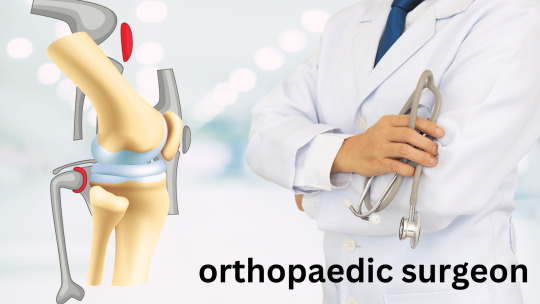#orthopaedicsurgeonsingapore
Text
Orthopaedic Care for Athletes and Active People
Orthopaedic care is essential for athletes of all levels, from recreational to elite. By understanding the unique orthopaedic needs of athletes, orthopaedic specialists can provide tailored care that helps athletes to prevent injuries, recover quickly from injuries, and achieve their performance goals.

Non-surgical orthopaedic treatments are often the first line of defense for orthopaedic injuries in athletes. These treatments can be effective in relieving pain, reducing inflammation, and improving function. Common non-surgical treatments include:
Physiotherapy: Physiotherapists use a variety of techniques to help athletes regain their range of motion, strength, and function. These techniques may include exercises, manual therapy, and modalities such as heat, ice, and electrical stimulation.
Medications: Orthopaedic specialists may prescribe medications to help athletes manage their pain and inflammation. Common medications include over-the-counter pain relievers, nonsteroidal anti-inflammatory drugs (NSAIDs), and corticosteroids.
Orthotics and bracing: Orthotics and bracing can be used to provide support and stability to injured joints. This can help to reduce pain and swelling, and promote healing.
If non-surgical treatments are not effective, or if the injury is severe or complex, surgery may be necessary. Common surgical orthopaedic interventions for athletes include:
Arthroscopy: Arthroscopy is a minimally invasive surgical procedure that can be used to diagnose and treat joint problems. A small camera is inserted into the joint through a small incision, and the surgeon can use specialized instruments to view and repair damaged tissues.
Ligament repair: Surgery may be used to repair torn ligaments, such as the ACL or PCL. This may involve suturing the torn ligament back together, or using a graft from another part of the body to replace the damaged ligament.
Tendon repair: Surgery may be used to repair torn tendons, such as the Achilles tendon or rotator cuff tendon. This may involve suturing the torn tendon back together, or using a graft from another part of the body to augment the repair.
Fracture repair: Surgery may be used to repair broken bones. This may involve open reduction internal fixation (ORIF), in which the broken bone is aligned and held in place with metal screws, plates, or nails. Or, it may involve closed reduction internal fixation (CRIF), in which the broken bone is aligned and held in place without
Once surgery has been performed, it is important for athletes to follow their surgeon's instructions carefully during the rehabilitation process. This will help to ensure a successful recovery and a return to play as soon as possible.
Rehabilitation after orthopaedic surgery typically includes a combination of physical therapy, occupational therapy, and strength and conditioning training. The specific goals of rehabilitation will vary depending on the type of surgery performed, but the overall goal is to help athletes regain their range of motion, strength, and function.
Physical therapy is an essential part of rehabilitation after orthopaedic surgery. Physical therapists can help athletes to:
Reduce pain and inflammation
Improve range of motion
Strengthen muscles around the injured area
Restore balance and coordination
Learn how to prevent future injuries
Occupational therapy may also be recommended for athletes after orthopaedic surgery. Occupational therapists can help athletes to learn how to perform activities of daily living (ADLs), such as bathing, dressing, and cooking, with the injured area. They can also help athletes to develop strategies for returning to work or school.
Strength and conditioning training is another important component of rehabilitation after orthopaedic surgery. Strength and conditioning coaches can help athletes to:
Build strength and power
Improve cardiovascular fitness
Improve proprioception (awareness of the body's position in space)
Reduce the risk of re-injury
It is important for athletes to be patient and realistic during the rehabilitation process. Healing takes time, and it is important to not rush the process. By following their surgeon's instructions and working hard in rehabilitation, athletes can maximize their chances of a successful recovery and a return to play.
Here are some additional tips for athletes who are recovering from orthopaedic surgery:
Listen to your body. Don't push yourself too hard, and don't be afraid to rest when you need to.
Be consistent with your rehabilitation exercises. Even if you're feeling better, it's important to continue doing your exercises to maintain your progress.
Communicate with your surgeon and physical therapist. If you have any questions or concerns, don't be afraid to ask.
Be patient. Healing takes time. Don't expect to be back to 100% overnight.
By following these tips, athletes can increase their chances of a successful recovery from orthopaedic surgery and a return to play.
#orthopedicsurgeon#orthopaedicsurgeon#orthopedicdoctor#orthopaedicdoctor#orthopaedicsurgeonsingapore
0 notes
Link
Best orthopaedic surgeon in sinagpore
There’s one thing that keeps an athlete going – perfect health. At SBF Sports and Hand Centre, we believe there’s always a solution. Be it joint pains, fractures, ligament tears or hand surgeries, our highly certified team of doctors is at your service. Our mission is to provide our patients with unparalleled service so they can leave out our doors stronger than ever. We’re obsessively passionate about meeting our goals, and we have just the right team to make the SBF Sports and Hand Center a success.
Visit our website for moe information.
0 notes